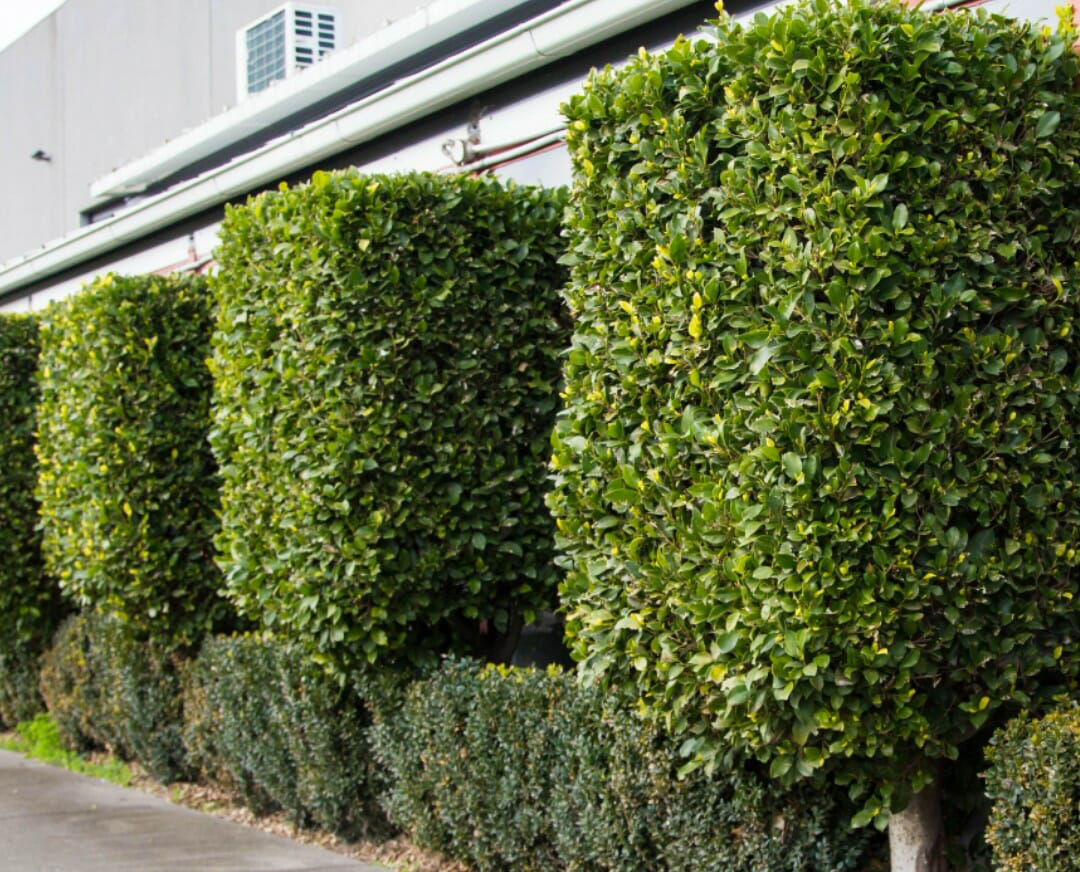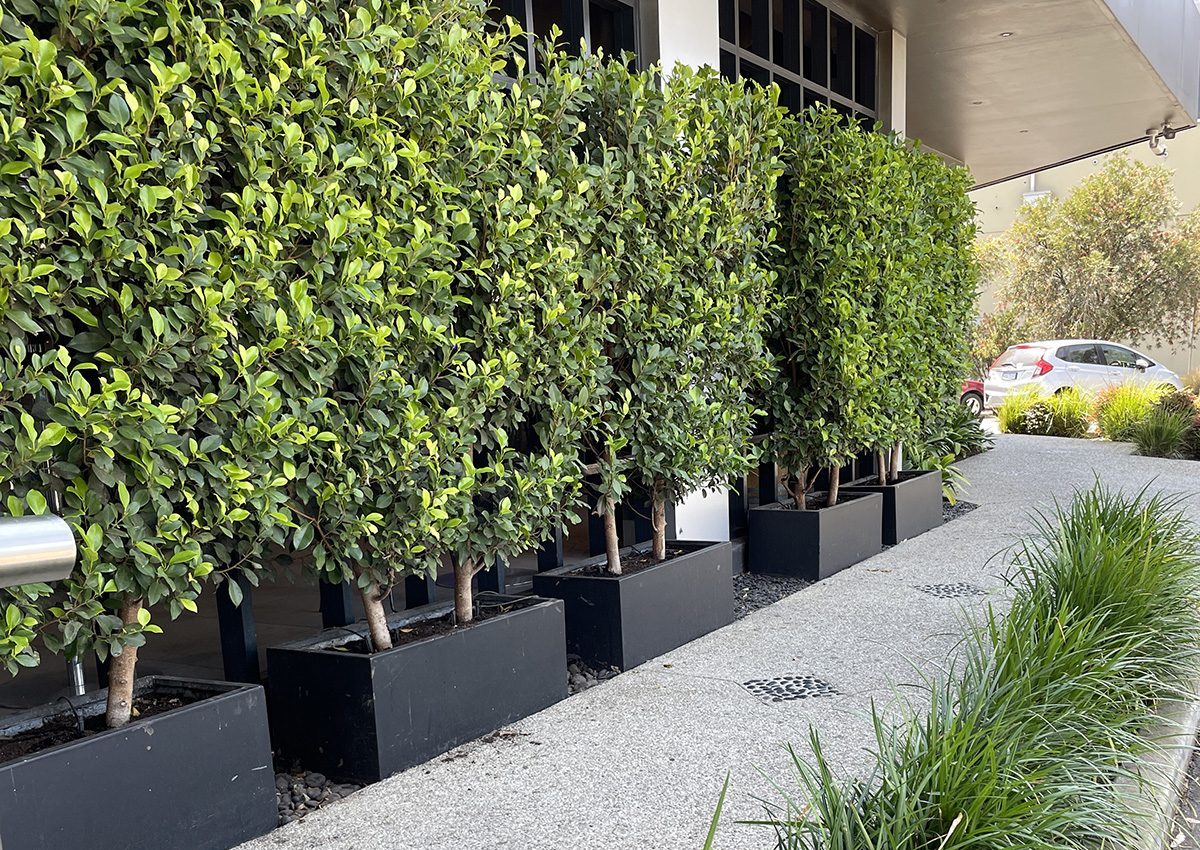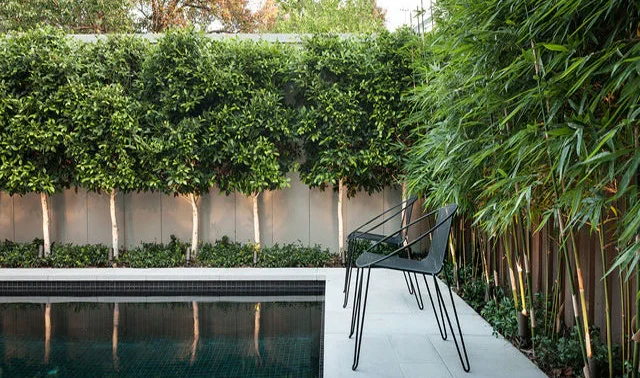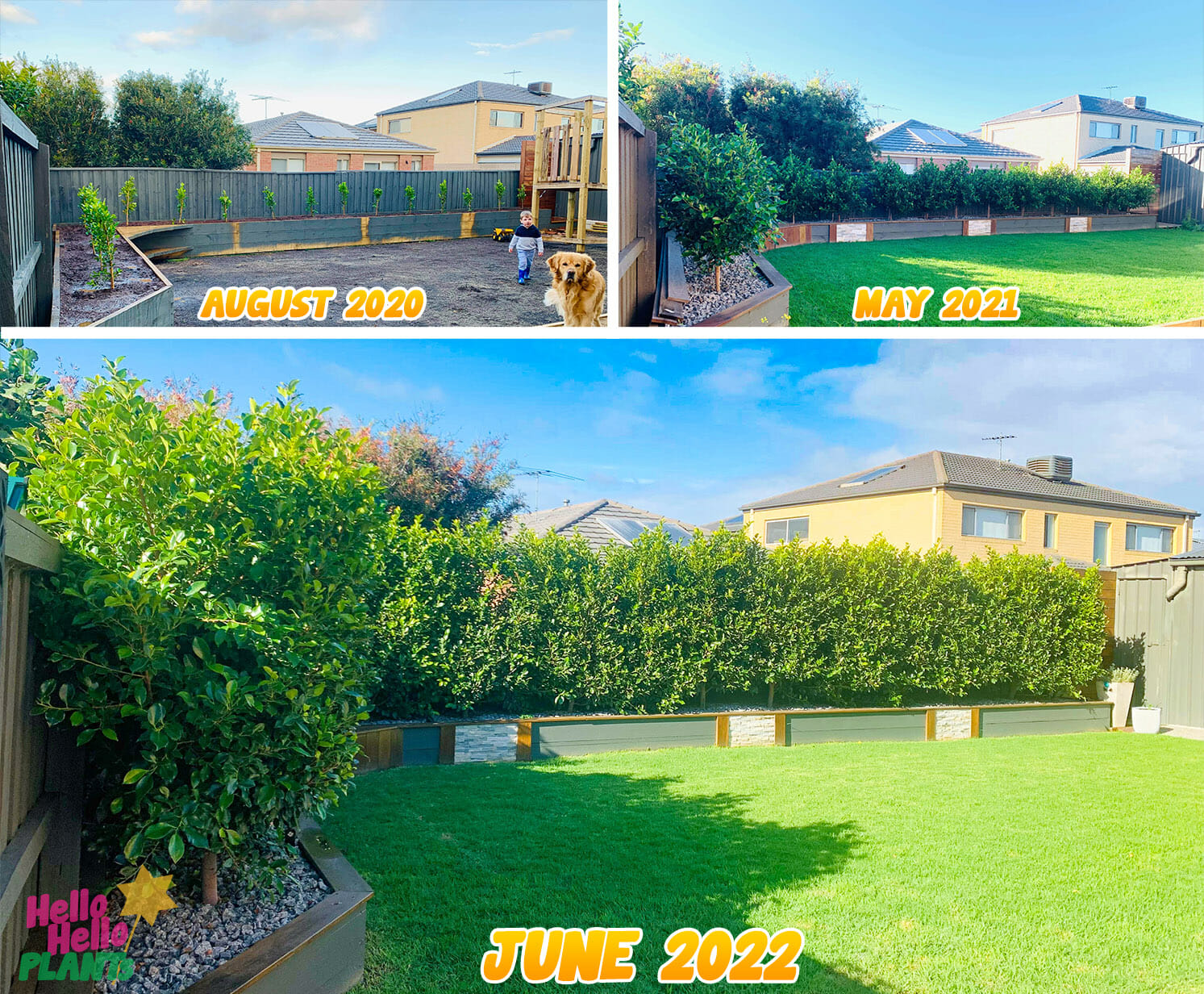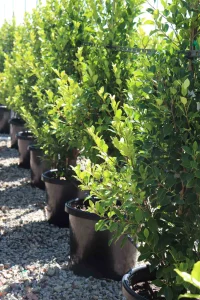 Now Ficus Flash is an incredibly versatile plant and I think that’s probably one of the reasons why it’s so popular. For example, you can grow Ficus Flash in pots and very often people come in to us because they have a balcony up high or a deck somewhere in Melbourne. It might be facing North or West. It might be in a very, very windy spot, with lots of sun and heat that dries things out. And they say, ”Chris, I’ve got no privacy on my balcony or my deck or whatever. How can I block it so no one looks in on me?” And I’ll always say the answer is Ficus Flash! If you forget to water it, it’s so forgiving. Now if you were to put a Japanese Maple in the same location for example, then the heat and the wind is going to get to it. If you forget to water your Maple the leaves will fall off. And it’s hard to get new leaves on it.
Now Ficus Flash is an incredibly versatile plant and I think that’s probably one of the reasons why it’s so popular. For example, you can grow Ficus Flash in pots and very often people come in to us because they have a balcony up high or a deck somewhere in Melbourne. It might be facing North or West. It might be in a very, very windy spot, with lots of sun and heat that dries things out. And they say, ”Chris, I’ve got no privacy on my balcony or my deck or whatever. How can I block it so no one looks in on me?” And I’ll always say the answer is Ficus Flash! If you forget to water it, it’s so forgiving. Now if you were to put a Japanese Maple in the same location for example, then the heat and the wind is going to get to it. If you forget to water your Maple the leaves will fall off. And it’s hard to get new leaves on it.
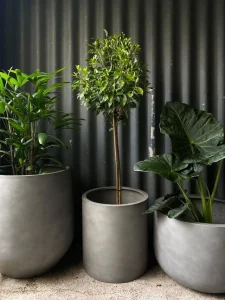 Whereas with Ficus Flash, it’s very forgiving. You can forget to water it occasionally and it won’t drop its foliage. You can forget to fertilise it, it’ll just hang in there. It’ll take the wind, it’ll take the heat, it’ll take the exposure. And it’ll also take coastal exposure. So, you can grow it close to surf beaches and things like that. Now you couldn’t grow it right on the beach, but most coastal spots around Victoria, you’ll find you can grow Ficus Flash quite close to the beach. So you can grow it in pots, you can grow it in planters, you can grow it near the beach.
Whereas with Ficus Flash, it’s very forgiving. You can forget to water it occasionally and it won’t drop its foliage. You can forget to fertilise it, it’ll just hang in there. It’ll take the wind, it’ll take the heat, it’ll take the exposure. And it’ll also take coastal exposure. So, you can grow it close to surf beaches and things like that. Now you couldn’t grow it right on the beach, but most coastal spots around Victoria, you’ll find you can grow Ficus Flash quite close to the beach. So you can grow it in pots, you can grow it in planters, you can grow it near the beach.
Now people often put Ficus Flash in an area that’s all concreted and they’ve got a confined root area, but they want something tall and fast to block out the neighbours. In those case I’ll always say grow your Ficus Flash in pots because it’ll stay green, be more forgiving and grow faster than almost any other evergreen that you can get.
Now there’s another other thing you can do that’s very popular with Ficus Flash and that is that you can pleach it. Now that’s where you basically create a hedge but it’s a high hedge that’s on long stalks. Now the sneaky way of doing this is, if you come in and buy a standard Ficus with a stem and a ball on top, then over time you trim the ball into a squarer shape, it’ll stop being a ball and grow out into a hedge shape.
 Pleaching is where you grow a hedge up on long stalks or stems. It’s ideal if you have a small back garden but you still want something tall to block out the neighbours or a bad view or give yourself some privacy. If you were to grow Ficus Flash or any type of hedge where it grows fully from the ground up, in a small back garden, well it makes your garden look even smaller. But if you pleach it so that all you see is the stalks and you can see your back fence through them, then your yard won’t look so small. Now the other great thing about pleaching is that then you can grow some colourful plants underneath, something low with nice flowers or something else green and lush but down at ground level so you still see the fence. You end up blocking out your neighbours, your garden doesn’t look too small and you have something pretty to look at, at ground level.
Pleaching is where you grow a hedge up on long stalks or stems. It’s ideal if you have a small back garden but you still want something tall to block out the neighbours or a bad view or give yourself some privacy. If you were to grow Ficus Flash or any type of hedge where it grows fully from the ground up, in a small back garden, well it makes your garden look even smaller. But if you pleach it so that all you see is the stalks and you can see your back fence through them, then your yard won’t look so small. Now the other great thing about pleaching is that then you can grow some colourful plants underneath, something low with nice flowers or something else green and lush but down at ground level so you still see the fence. You end up blocking out your neighbours, your garden doesn’t look too small and you have something pretty to look at, at ground level.
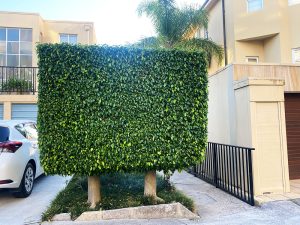 Now the great thing about pleaching, with a plant like Ficus Flash is you can make it look very, very elegant. So if you’re looking to create a very smart, manicured, traditional kind of look for your property, then Ficus Flash can be the answer. Often you might combine Ficus Flash with English Box hedges, or Japanese Box hedges, or maybe Asiatic Jasmine or Chinese Jasmine as a ground cover.
Now the great thing about pleaching, with a plant like Ficus Flash is you can make it look very, very elegant. So if you’re looking to create a very smart, manicured, traditional kind of look for your property, then Ficus Flash can be the answer. Often you might combine Ficus Flash with English Box hedges, or Japanese Box hedges, or maybe Asiatic Jasmine or Chinese Jasmine as a ground cover.
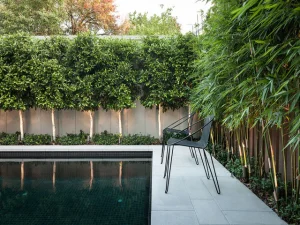 Another area where we are putting a lot of pleached hedges in particularly is around swimming pools. Naturally a lot of people are looking to put screens up around their pools for privacy, but you’ve got to have straight stems on the lower part of the pleached hedge that kids can’t climb. What you do is trim up your Ficus Flash with the screen up nice and high with the stems all trimmed so it can’t be climbed by children. This can make it safe and legal for your pool. Whereas you might not be able to just have a bushy hedge around your pool because the kids could use to climp up on and get over the pool fence, you can put in a pleached hedge, and Ficus Flash is great for that.
Another area where we are putting a lot of pleached hedges in particularly is around swimming pools. Naturally a lot of people are looking to put screens up around their pools for privacy, but you’ve got to have straight stems on the lower part of the pleached hedge that kids can’t climb. What you do is trim up your Ficus Flash with the screen up nice and high with the stems all trimmed so it can’t be climbed by children. This can make it safe and legal for your pool. Whereas you might not be able to just have a bushy hedge around your pool because the kids could use to climp up on and get over the pool fence, you can put in a pleached hedge, and Ficus Flash is great for that.
So basically your Ficus Flash is very versatile. You can grow them as a standard plant, you can pleach them, you can grow them in pots, you can grow them in a garden bed and you can grow them in a coastal situation. You can grow them in high wind areas, you can grow them in hot, sunny exposed areas. Basically you can grow them anywhere, where they’re going to experience a little bit of dryness.
 I remember one year when we had the bad drought about 10 or 12 years ago. We had a couple of big bushfire days and the temperatures got up around 46 degrees. Everywhere I went around Melbourne, I saw leaves burnt on plants. Some plants had completely defoliated and some plants had even died from the heat. But what I noticed, I had some customers who had Ficus hedges and there wasn’t one single burnt leaf. They were absolutely green and fabulous. So tremendous heat tolerance. Here it was 46 degrees and they had no worries at all.
I remember one year when we had the bad drought about 10 or 12 years ago. We had a couple of big bushfire days and the temperatures got up around 46 degrees. Everywhere I went around Melbourne, I saw leaves burnt on plants. Some plants had completely defoliated and some plants had even died from the heat. But what I noticed, I had some customers who had Ficus hedges and there wasn’t one single burnt leaf. They were absolutely green and fabulous. So tremendous heat tolerance. Here it was 46 degrees and they had no worries at all.
So where you’ve got a lot of paving and you’re going to get a lot of reflected heat that’s going to make it really, really hot, the Ficus is naturally protected against extreme heat.
So basically your Ficus Flash is a very useful and versatile plant. Now your Ficus does have some limitations and it’s good to know the limitations so that you know how to cope with those limitations.
 I remember a famous TV gardener did an “expose” on Ficus. He went and visited a garden where someone had planted a Ficus tree and then had never done anything to it, never trimmed it, never maintained it for like nearly 50 years. And what had happened is that this Ficus tree had grown absolutely enormous and covered the whole front garden. And it had destroyed the brick fence and all the concrete area so the garden looked like it’d been hit by an atom bomb!
I remember a famous TV gardener did an “expose” on Ficus. He went and visited a garden where someone had planted a Ficus tree and then had never done anything to it, never trimmed it, never maintained it for like nearly 50 years. And what had happened is that this Ficus tree had grown absolutely enormous and covered the whole front garden. And it had destroyed the brick fence and all the concrete area so the garden looked like it’d been hit by an atom bomb!
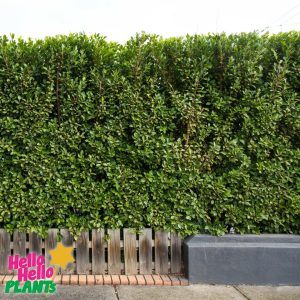 But it was a tree that had been completely neglected for 50 years and totally destroyed the garden. Everyone thought it was shocking. But what this TV gardener didn’t actually mention was how it occurred or how you’d prevent it. They just said, don’t plant Ficus, they’re terrible, look what they’re going to do to your property.
But it was a tree that had been completely neglected for 50 years and totally destroyed the garden. Everyone thought it was shocking. But what this TV gardener didn’t actually mention was how it occurred or how you’d prevent it. They just said, don’t plant Ficus, they’re terrible, look what they’re going to do to your property.
The truth about Ficus is that there’s hundreds of thousands of them planted in Melbourne. And when they’re properly managed, they’re not causing a problem at all.
Now there’s another Ficus on the market, you’ll find it on our website called Ficus Koh. Now where a normal Ficus left to its own devices will grow into a very large tree, the Ficus Koh is actually just a large bush. If you knock one out of its pot, you’ll see it doesn’t have the same roots as the other Ficus. It has a less aggressive root system. So if for instance, you want to plant Ficus in a more sensitive area, like say right next to the pool, by planting the Ficus Koh, you’ll have less of a problem. So in these kind of case, if you plant the Ficus Koh and control its height and width, which is easy to do because it’s not a real big growing tree, you’ll certainly have that problem licked.
 Another problem with Ficus is extreme frost can cause them to go black or brown over the top. In a few weeks after that the leaves will fall off, but then as soon as the weather warms up again, the leaves will grow back again. So basically frost can be a limitation for your Ficus but it will recover mostly. Unless it’s in a really, really frosty area and then your Ficus can actually be killed by frost.
Another problem with Ficus is extreme frost can cause them to go black or brown over the top. In a few weeks after that the leaves will fall off, but then as soon as the weather warms up again, the leaves will grow back again. So basically frost can be a limitation for your Ficus but it will recover mostly. Unless it’s in a really, really frosty area and then your Ficus can actually be killed by frost.
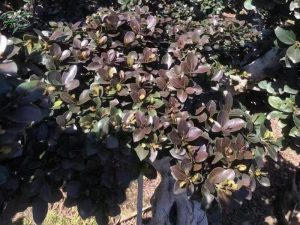 Now I was talking to a nursery person in Mildura recently and she told me that once you get through the first couple of years of frost, your Ficus will become much more frost hearty. Now she grew grew Ficus Flash and Ficus Hillii commercially in Mildura, which has very severe frost down to -4° or -5° or even -6°,. She said that the Ficus Hillii is very frost hardy compared to the Ficus Flash.
Now I was talking to a nursery person in Mildura recently and she told me that once you get through the first couple of years of frost, your Ficus will become much more frost hearty. Now she grew grew Ficus Flash and Ficus Hillii commercially in Mildura, which has very severe frost down to -4° or -5° or even -6°,. She said that the Ficus Hillii is very frost hardy compared to the Ficus Flash.
So if you’re in the sort of area where you might be worried by severe frost say in the high country out around Daylesford or something like that where you might be in trouble with Ficus Flash, you may find that Ficus Hillii has got that extra frost resistance you need.
Now the Ficus Koh is also quite frost resistant as well. So in extreme frost areas, you might consider the Ficus Hillii or the Ficus Koh instead of the Flash. The Flash can take quite a bit of frost but not as much frost as the Hillii or the Koh.
The next problem that people have with Ficus Flash is drainage. Now where you have very, very bad drainage or where the ground’s likely to become flooded or super duper wet for long periods that’s not good for Ficus Flash. A bit of wet feet can stunt them but a lot of wet feet will actually kill ’em.
So it’s good to put in an agricultural drain or raise the garden bed up a bit. It doesn’t have to be extremely well drained for the Ficus Flash. But they do have to be at least moderately well drained and always be careful not to put them into a really sort of a wet hollow.
 Now another weak point of all of your Ficus is shade. Now if you are planting a Ficus hedge and you have one end that is hot and sunny and the other end is only getting a little bit of sun then what I’d do is plant advanced, well grown Ficus Flash in the slightly sunny area and smaller, less developed ones in the very hot sunny area.
Now another weak point of all of your Ficus is shade. Now if you are planting a Ficus hedge and you have one end that is hot and sunny and the other end is only getting a little bit of sun then what I’d do is plant advanced, well grown Ficus Flash in the slightly sunny area and smaller, less developed ones in the very hot sunny area.
But if you’ve got one end of where you want to plant it that is lovely and sunny and the other end that is always in shade because there’s a 3-storey building next door, well that’s not really a spot for Ficus Flash. This is more a place for something like Sweet Viburnum because it seems to grow quite happily in complete shade, which is where your Ficus really falls down. So if you’ve got no sun at one end of your garden and lots of sun at the other end and you want the same hedge all the way through, consider Sweet Viburnum.
Another thing to remember about Ficus Flash and this is true of a lot of evergreens, if you’re growing your Ficus in a pot, you’ll find that even though you might be putting fertiliser like Osmocote on it every three months or six months or whatever, you might find that it starts to yellow after a while. So you put on a bit more fertiliser and it doesn’t even pick up and you don’t know what to do.
 What’s actually happening here is that when you buy a fresh new potting mix its got quite a good dose of calcium in it. Now calcium is represented as dolomite lime or lime. So your fresh new potting mix that you planted your Ficus Flash in had a good dose of calcium in it at the start and evergreens like Ficus need calcium to help them get the nitrogen out of the soil. And then when there’s no calcium left, they can’t have access to the nitrogen. There’s sort of a blockage there.
What’s actually happening here is that when you buy a fresh new potting mix its got quite a good dose of calcium in it. Now calcium is represented as dolomite lime or lime. So your fresh new potting mix that you planted your Ficus Flash in had a good dose of calcium in it at the start and evergreens like Ficus need calcium to help them get the nitrogen out of the soil. And then when there’s no calcium left, they can’t have access to the nitrogen. There’s sort of a blockage there.
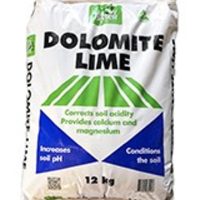 So if you’re growing Ficus in pots and they’re yellowing and they’re not responding your NPK fertiliser such as Osmocote, what you’ve got is a calcium or lime deficiency. I recommend that if you’re growing them in pots, at least once a year at a minimum and perhaps twice a year, you should put a really good dose of dolomite lime in there. Now don’t do that at the same time as your Osmocote because the calcium and nitrogen tend to conflict a bit with each other.
So if you’re growing Ficus in pots and they’re yellowing and they’re not responding your NPK fertiliser such as Osmocote, what you’ve got is a calcium or lime deficiency. I recommend that if you’re growing them in pots, at least once a year at a minimum and perhaps twice a year, you should put a really good dose of dolomite lime in there. Now don’t do that at the same time as your Osmocote because the calcium and nitrogen tend to conflict a bit with each other.
 So if I had some Ficus that had been in say 20 inch or 24 inch pots for a long time and they were yellowing a little bit, not really greening up, I’d put a really big cupful of dolomite lime into the pot and spread it around. Let it soak in for a month or so, and then I’d put my Osmocote on. This will have a good effect and you’ll get them green and growing again.
So if I had some Ficus that had been in say 20 inch or 24 inch pots for a long time and they were yellowing a little bit, not really greening up, I’d put a really big cupful of dolomite lime into the pot and spread it around. Let it soak in for a month or so, and then I’d put my Osmocote on. This will have a good effect and you’ll get them green and growing again.
So basically summing the limitations of your Ficus Flash, there’s your roots, there’s your frost, there’s your drainage, your shade, and also having them yellow through a lack of calcium. But you can solve all of those as I just explained.
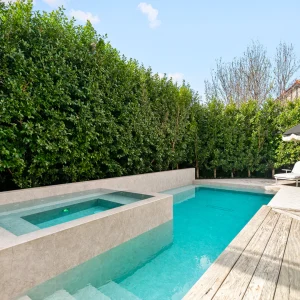 So where are the most popular places where you can use your Ficus Flash. The No. 1 use is probably the swimming pool or where you’re wanting some privacy from the road or from the apartments or flats next door and you need it fast. You need it to look green and lush and you want it to look classy. But you don’t want it to be sparse, you don’t want it to be see-through. Well, what you can do is plant your Ficus in a one metre spacing and Osmocote them every six weeks in the warm weather. Really drown them in water once a week and give ’em a few squirts through the week and you can grow them well over a metre a year. Now depending on how high you need them, well in 2, 3 or 4 years you’ll have that problem solved completely.
So where are the most popular places where you can use your Ficus Flash. The No. 1 use is probably the swimming pool or where you’re wanting some privacy from the road or from the apartments or flats next door and you need it fast. You need it to look green and lush and you want it to look classy. But you don’t want it to be sparse, you don’t want it to be see-through. Well, what you can do is plant your Ficus in a one metre spacing and Osmocote them every six weeks in the warm weather. Really drown them in water once a week and give ’em a few squirts through the week and you can grow them well over a metre a year. Now depending on how high you need them, well in 2, 3 or 4 years you’ll have that problem solved completely.
 Now some people want to know how fast Ficus Flash can grow in metres. Well that depends. The bigger they are when you get them, the more growth you can get from them. So I’ve seen customers buy the 16 inch pot, which normally would stand about 1.8 meters tall and I’ve seen them grow up to 3 metres in a year. But if you were to get a 6 inch pot, I would say that it would take 2 years in Melbourne conditions to have that up to just over 2 metres tall.
Now some people want to know how fast Ficus Flash can grow in metres. Well that depends. The bigger they are when you get them, the more growth you can get from them. So I’ve seen customers buy the 16 inch pot, which normally would stand about 1.8 meters tall and I’ve seen them grow up to 3 metres in a year. But if you were to get a 6 inch pot, I would say that it would take 2 years in Melbourne conditions to have that up to just over 2 metres tall.
 Basically with Ficus Flash the bigger you buy them, the more growth potential they have that year. So if you buy fairly advanced ones, they have the ability to grow more than a metre a year with perfect conditions and lots of sun and lots of heat. Probably the upper limits of what you can achieve is about one and a half metres in a year.
Basically with Ficus Flash the bigger you buy them, the more growth potential they have that year. So if you buy fairly advanced ones, they have the ability to grow more than a metre a year with perfect conditions and lots of sun and lots of heat. Probably the upper limits of what you can achieve is about one and a half metres in a year.
Now if I’m growing Ficus Flash near a pool for a big screen, I’d want them quite tall so I’d probably start with planting 1.8 metre plants in 40-50 cm pots. I wouldn’t go for those big long planters as they will end up too close together and that can be very expensive. Better to have say 40-50 cm cubes and space them out a bit and you’ll get a nice, evenly space hedge.
Now there are some really good videos on Ficus Flash if you just click the video icon at the top right corner of this website page and that will take you to our youtube channel. Just search Ficus when you are there.
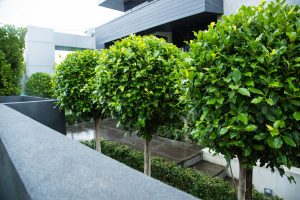 Another popular application for Ficus Flash is using them as standards – say up the side of the driveway or up the side of the garden path, where you want to have something that’s never going to get too big. The old Ficus ball on a stick in many ways beats the standard rose because the standard rose might look fabulous in flower, but it can look pretty spongy in the winter. Whereas your Ficus Flash done as a ball on a stick looks green and lush in summer, maybe not quite as good as a standard rose covered in flowers but nearly as good. But then it looks really good right through autumn and winter and right through spring when the rose is looking a bit yuck.
Another popular application for Ficus Flash is using them as standards – say up the side of the driveway or up the side of the garden path, where you want to have something that’s never going to get too big. The old Ficus ball on a stick in many ways beats the standard rose because the standard rose might look fabulous in flower, but it can look pretty spongy in the winter. Whereas your Ficus Flash done as a ball on a stick looks green and lush in summer, maybe not quite as good as a standard rose covered in flowers but nearly as good. But then it looks really good right through autumn and winter and right through spring when the rose is looking a bit yuck.
In Closing
So there you have everything you need to know about the Ficus Flash, where you can use it, it’s limitations and how you can overcome them.
If you want really good deals on Ficus Flash, search this website and you’ll see you can get great prices on all our Ficus range.
Till next time, bye from Chris!



